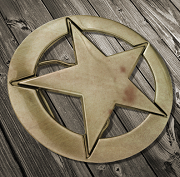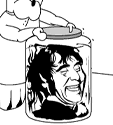|
Zak S posted:There is a disconnect in the use of the term in different gaming communities. In the OSR, "simplicity" does not necessarily translate to "clarity about what to do with a given moving part". It is more about reducing PC and monster statblocks down to very short sets of numbers that are quick to generate for players or quick to think up for GMs inventing enemies. So in more flowery terms exactly what I said. OSR Simplicity is simplicity to people who already memorized/know the rules in question.
|
|
|
|

|
| # ? Apr 27, 2024 02:40 |
Red_Mage posted:So in more flowery terms exactly what I said. OSR Simplicity is simplicity to people who already memorized/know the rules in question. ...or to new players who can remember the 3 terms in the string and who consider deciding what to do with the monster described a trivial task. Like most OSR stuff now is written in a sort of skeletal (AC 8 or 12, HP 23, ATK +5 2-8dmg) format. That's 3 terms to remember, all of which appear in all D&Ds in one way or another. Some have a move stat appended. Special attacks and defenses are generally described completely out (more rarely: "as Sleep spell" or anything like that since different editions and clones use different versions of spells). The not-simple part is not rules in this case, but knowing what to do with that creature as a GM to make an interesting game.
|
|
|
|
|
It's more than that. "2-8" is a big example of relying on the target's preexisting knowledge to figure out how you're supposed to generate numbers in that band. Is it roll an 8-sided die? No, that wouldn't give you 2 as the lowest number. Is it roll a 6-sided die and add 1? No, that wouldn't give you 8 as the highest number. Is it roll a 10-sided die and subtract 2? No, too negative. I guessed that it might be roll two 4-sided dice and add them together, but honestly, you could also roll a 12-sided die, add 3, then divide by 2 and round up to get the same range. And 2d4 produces a different variation in numbers than just having something like 1d7+1 on a computerized RNG, so figuring out what exactly your random numbers mean is a problem. Now, what if the range was 5-11?
|
|
|
|
Zak S posted:...or to new players who can remember the 3 terms in the string and who consider deciding what to do with the monster described a trivial task. What is the advantage of using 2-8 damage instead of just saying 2d4? It's exactly the same number of characters and is much easier to understand.
|
|
|
LightWarden posted:It's more than that. "2-8" is a big example of relying on the target's preexisting knowledge to figure out how you're supposed to generate numbers in that band. That is all true. In the entry level OSR products (that is--the actual clones and other game--which are, in general, the least exciting) this stuff is usually explained. In the supplements and blog entries it isn't and the audience is assumed to be familiar with whatever systems that product supports. If Idol of the Frog God were sold by WOTC for mass consumption rather than distributed free to a few hundred hobbyists, I'd say writing "2d6" instead of "2-12" would be wise. I also don't think its author would disagree with me.
|
|
|
|
|
Point is: when OSR people say "simple" they usually mean "not a lot of stats and not a lot of interlocking math between those stats".
|
|
|
|
|
Let's not be cranky about the format, monster on an index card is a noble goal.
|
|
|
|
|
I know someone who claims that when they were young they had no idea that you were supposed to use dice with D&D. So whenever they saw a random number, they would flip coins D02-style and subtract to get the right range. I'm not sure I believe them.
|
|
|
|
Zak S posted:That is all true. In the entry level OSR products (that is--the actual clones and other game--which are, in general, the least exciting) this stuff is usually explained. In the supplements and blog entries it isn't and the audience is assumed to be familiar with whatever systems that product supports. So, there's no good reason to use 2-8 instead of 2d4 other than bullshit nostalgia, then. Good to know.
|
|
|
|
LightWarden posted:Now, what if the range was 5-11? Well, the range would never be 5-11 because you can't get that range from the dice. The whole 1-6, 2-8, 5-12, etc. is a throwback to before the adoption of the XdY notation, and that's why it's dumb to still use it; it's been replaced by a much clearer notation.
|
|
|
Piell posted:So, there's no good reason to use 2-8 instead of 2d4 other than bullshit nostalgia, then. Good to know. Not at all--if you're looking down a long weapon chart (as you do when shopping in AD&D) number ranges are often more quickly telling than die arrangements in terms of which weapon you want to buy (in a die arrangement like 2d6 sometimes the first number in the series is important compared to another and sometimes the third term is). Then you pick a weapon based on the damage range, do the math to figure what die to use, and have that die ready for every fight. If you're looking at a short list of powers in a combat (as you do in 4e) and comparing them to each other, then die arrangements are more helpful because it is easy to play "which of these 3 digits (2d6+4 or 3d6+4) is better" because it's a shorter list and usually each only differs from the other by one term and it's pretty obvious. They fit their context, in other words. But both require a tiny bit of math to get all the information you might want.
|
|
|
|
|
All I can say as someone coming into this blind is that '2-8' means '-6' to me.
|
|
|
|
Clearly the skeleton does 1d7+1 damage.
|
|
|
|
|
Zak S posted:Not at all--if you're looking down a long weapon chart (as you do when shopping in AD&D) number ranges are often more quickly telling than die arrangements in terms of which weapon you want to buy (in a die arrangement like 2d6 sometimes the first number in the series is important compared to another and sometimes the third term is). Then you pick a weapon based on the damage range, do the math to figure what die to use, and have that die ready for every fight. Nah man, this is a load of crap to defend an archaic notation that's only used for "oldschool" aesthetics. Figuring out the maximum possible on XdY is a lot easier than figuring how to achieve the given range, especially for a new player. XdY is a huge QoL improvement. The person who invented it deserves an award and a pension. And poo poo, man. Most weapons only do 1d of damage anyway, so it's incredibly easy to figure out their max damage.
|
|
|
|
Zak S posted:Not at all--if you're looking down a long weapon chart (as you do when shopping in AD&D) number ranges are often more quickly telling than die arrangements in terms of which weapon you want to buy (in a die arrangement like 2d6 sometimes the first number in the series is important compared to another and sometimes the third term is). Then you pick a weapon based on the damage range, do the math to figure what die to use, and have that die ready for every fight. This is not making things 'simpler' it's just adding more bullshit hoops for the player to jump through. You could do all that or look at a table where the values are clearly listed like XdY, etc. I mean, the whole 'doing the math to figure out blah blah" is needless and dumb. It's extra dumb because, well, let me quote something LightWarden posted:It's more than that. "2-8" is a big example of relying on the target's preexisting knowledge to figure out how you're supposed to generate numbers in that band. Congrats, instead of clearly just listing XdY (which takes up literally the exact same space of 2-8) you have created a really dumb mechanic that relies on the players previous knowledge of games to get technically correct and can easily lead to pointless misunderstandings. Why do this? It's just not good or simple even by a skewed definition of simple.
|
|
|
|
PeterWeller posted:Nah man, this is a load of crap to defend an archaic notation that's only used for "oldschool" aesthetics. Figuring out the maximum possible on XdY is a lot easier than figuring how to achieve the given range, especially for a new player. XdY is a huge QoL improvement. The person who invented it deserves an award and a pension.
|
|
|
|
Guys, guys, come on. It's like you're forgetting that RPGs are supposed to be a mystery cult.
|
|
|
|
projecthalaxy posted:Guys, guys, come on. It's like you're forgetting that RPGs are supposed to be a mystery cult. Yeah, we can't have stuff that's easy to read. Then
|
|
|
|
I think you may have missed something. Again, imagine you are shopping in AD&D. There is a list of weapons a page long. If you have number ranges you only have to look at one column all the way down to see which weapons do more damage (and the first column only says 1 or 2). If you have die ranges you have to look at 2 separate columns. The 6 at the end of 2d6 makes it bigger than 2d4 whereas the 3 at the beginning of 3d6 makes it bigger than 2d6. It entirely depends on what situation you're imagining. And, again, in both cases you have to do math. Die arrangements make a lot of sense when there are a few numbers to look at and those numbers are big, number ranges make sense when the numbers are lower and there are a lot of them. And even if it isn't easier for you, I can tell you it is for my (totally new to gaming) players and I don't have a motive to lie about that.
|
|
|
|
|
That's totally fine that it's for your players! Nobody in here is trying to take that away from them. What's being said is, the mechanic is dated, and not for everyone. Also, the only thing you have said to defend your claim is "it's the way it was in AD&D", which is not a valid reason for something to be the way it is.
|
|
|
|
Zak S posted:Die arrangements make a lot of sense when there are a few numbers to look at and those numbers are big, number ranges make sense when the numbers are lower and there are a lot of them. 1d4 1-4 Wow, New/dice notation work for small numbers too. Also the "Well I like it and so do my friends!" white noise isn't a decent argument. Hell, it's not even an argument. I mean, people can like things that are bad/outdated, that doesn't justify the thing's use when there are much better ways of doing things that are the same thing, but stated more clearly. Especially when you're talking about it from a game design point of view.
|
|
|
|
Did you guys skip the part of my post where I described how if you're scanning a long column of weapon damage numbers if it's a range you only have to look at one column whereas if it's a die arrangement you have to look at two columns and then multiply out? 1d4 is a bad example. Small numbers like 2d8 vs 3d4 are more like what I'm talking about.
|
|
|
|
|
Zak S posted:Did you guys skip the part of my post where I described how if you're scanning a long column of weapon damage numbers if it's a range you only have to look at one column whereas if it's a die arrangement you have to look at two columns and then multiply out? 2d8 vs 2-16 3d4 vs 3-12 Yeah, so much different in terms of space. Also what the gently caress weapon does 2d8 or 3d4
|
|
|
|
You still run into the problem in which you need to induce the combination of dice necessary for a given value range. If char-op is a concern, it might be easier to add a separate "average damage per hit" column to the data table. Using "Damage X-Y" notation to try to make "average damage per hit" easier to calculate isn't worth the extra difficulty of finding how you roll for that damage in the first place. It's better to present datum A directly, or (oh my god) data A AND B SIMULTANEOUSLY HOLKY poo poo than use a clunky intermediary notation from which the player has to derive both of those numbers every time. Maybe including weapons' DPR would make the game too appealing to WoW retard babies like myself, and you wouldn't want to poison the hobby with toxic funhavers like myself. I guess I'm just too stupid to play a real roleplaying game.
|
|
|
Piell posted:2d8 vs 2-16 I'm not talking about how much space it takes up, I'm talking about how easy or hard it is to scan for the biggest weapon damage if you have a whole column of those.
|
|
|
|
|
Zak S posted:I'm not talking about how much space it takes up, I'm talking about how easy or hard it is to scan for the biggest weapon damage if you have a whole column of those. Literally nothing does 2d8 or 3d4, you're dumb.
|
|
|
|
Zak S posted:Did you guys skip the part of my post where I described how if you're scanning a long column of weapon damage numbers if it's a range you only have to look at one column whereas if it's a die arrangement you have to look at two columns and then multiply out? Oh, no, I might have to look two characters to the right or left! It's much easier to obfuscate the actual mechanics and let someone scratch their head at gauging 2-16 and 3-12 and work back into what it actually is instead of telling them what it's supposed to actually be!
|
|
|
Death Pits of Crap posted:You still run into the problem in which you need to induce the combination of dice necessary for a given value range. If char-op is a concern, it might be easier to add a separate "average damage per hit" column to the data table. Using "Damage X-Y" notation to try to make "average damage per hit" easier to calculate isn't worth the extra difficulty of finding how you roll for that damage in the first place. The best would obviously be to provide both but the point is there is actually a real rationale for doing it either ways if you have actual context. That is, while many things in AD&D were done that way for dumb reasons, this one has a reason and is not just repeated today out of nostalgia or a desire to have less people play the game.
|
|
|
|
|
Zak S posted:Did you guys skip the part of my post where I described how if you're scanning a long column of weapon damage numbers if it's a range you only have to look at one column whereas if it's a die arrangement you have to look at two columns and then multiply out? Ah yes, 3-12. 1d10+2. Okay, dropping the smug rear end in a top hat act. It's not any harder to do either way but the newer notation has an advantage when it comes to clarity. With the old 1-2 method you sit down, see both numbers, figure out what dice go there which as I said could be multiple different sets of numbers to total that amount. Now people who are already gamers this method would be fine and dandy and on equal footing with the new notation, because you've got years of experience and and generally think 'Hmm, no that seems silly compared to what other games have asked me to roll'. But to a new player it's a bit unintuitive. With the newer notation its left side is min. damage, multiply with second number to get max, something anyone past 4th grade can do in their head p. much instantly. And the beauty of this system is that you know exactly what dice you have to use. It's a cleaner system that takes no more time or effort or space than the old notation and it's understandable by almost everyone who picks up the book. There is no reason to use the old notation other than "Well that's just how I like it" which is fine, but it's just subpar and kinda dumb if you want to bring in new people.
|
|
|
|
Yes, because the maximum possible damage it would do is the only reason to choose a weapon, right? EDIT: Asimo posted:(as seen by the 1d7+1 joke)
|
|
|
|
|
If space isn't an issue just have the average damage and/or range alongside the die roll. The dice roll needed for the damage is the more important information when it comes to actually using the weapon in-game. If you're only going to show one, it's far better to show the die notation. It's easier to derive the range and rough estimate of damage by looking at the die notation than vice versa.
|
|
|
|
ZeeToo posted:Oh, no, I might have to look two characters to the right or left! You're assuming the end point is to know what dice to roll. Realistically, a player wants to know both things: the maximum damage s/he can cause and which dice to roll. Each notation provides one of those 2 important pieces of information instantly.
|
|
|
|
|
Zak, I refuse to believe that everyone you've played with is incapable of basic multiplication.
|
|
|
|
Zak S posted:You're assuming the end point is to know what dice to roll. Realistically, a player wants to know both things: the maximum damage s/he can cause and which dice to roll. Except anyone who can multiply by 2 can find the maximum damage quickly. On the other hand, when the DM is looking to see what kind of damage dice he needs to roll for the monster he needs to either have the entire possible list memorized or start busting out algebra and then guessing.
|
|
|
Zak S posted:You're assuming the end point is to know what dice to roll. Realistically, a player wants to know both things: the maximum damage s/he can cause and which dice to roll. And one notation can derive the other more easily than the other way around. XdY makes it far easier to figure out both things than showing just the range.
|
|
|
|
|
Zak S posted:You're assuming the end point is to know what dice to roll. Realistically, a player wants to know both things: the maximum damage s/he can cause and which dice to roll. "Maximum damage" seems like a figure that players would need to know much less often than "damage roll method." If finding the max damage takes a few seconds, that's okay, because you only choose a weapon (or use a "max weapon damage" mechanic) once in a while, but actually rolling for damage is something you do all the goddamn time. I understand that there is a rationale here, but it seems to come from a bad set of priorities.
|
|
|
Hamboning posted:Zak, I refuse to believe that everyone you've played with is incapable of basic multiplication. My blog's not called "Playing D&D With People Who All Graduated High School". I will tell you right now, if I tell Kimberly Kane she's got a 3d6 weapon or a 4d4 spell she will not know which does more damage. But, more than that, no matter which is easier for you, the idea that the only reason to use number range is nostalgia is on the face of it silly. Not everyone is you. It depends on who's playing.
|
|
|
|
Zak S posted:My blog's not called "Playing D&D With People Who All Graduated High School". Multiplication of the size of numbers that are relevant here is something that most schools I know of had students memorize by like 3rd grade.
|
|
|
|
|
You've literally presented no reason to use 4-16 instead of 4d4. You've told us some pretty good reasons to use 4-16 as well as 4d4, but no-one's arguing against that.
|
|
|
|

|
| # ? Apr 27, 2024 02:40 |
|
Zak S posted:
It is silly! Very silly! Whoever would try to make that arguement? Zak S posted:I think you may have missed something.
|
|
|






















